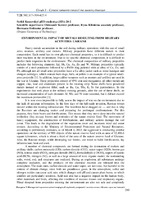Будь ласка, використовуйте цей ідентифікатор, щоб цитувати або посилатися на цей матеріал:
http://ir.nmu.org.ua/handle/123456789/162568| Назва: | ENVIRONMENTAL IMPACT OF METALS RESULTING FROM MILITARY ACTIVITIES: UKRAINE |
| Автори: | Krasovskyi, Serhii Kovrov, Oleksandr Klimkina, Iryna |
| Дата публікації: | 2022 |
| Видавництво: | НТУ ДП |
| Бібліографічний опис: | Krasovskyi Serhii ENVIRONMENTAL IMPACT OF METALS RESULTING FROM MILITARY ACTIVITIES: UKRAINE / Serhii Krasovskyi , Oleksandr Kovrov , Iryna Klimkina // Молодь: наука та інновації : матеріали 10-ої всеукр. наук.-техн. конф. студентів, аспірантів і молодих учених, м. Дніпро, 23–25 листопада 2022 р. – Дніпро : НТУ ДП, 2022.- С. 249-250 |
| Короткий огляд (реферат): | Heavy metals accumulate in the soil during military operations with the use of small arms, mortars, artillery and rockets. Military projectiles have different metals in their composition. Each metal has its own physico-chemical properties, so it is difficult to predict their reactions in the environment. Due to its specific chemical composition, it is difficult to predict their migration in the environment. The chemical composition of military projectiles includes the following elements: Ld, Sb, Cu, As, Zn and W. Military projectiles typically consist of a steel penetrator followed by a Pb/Sb slug jacketed with an alloy of Cu, Zn, and Pb, although not all small arms projectiles have a Cu alloy jacket such as some handgun and shotgun cartridges, which contain bare slugs, balls, or pellets is an example of a typical small arms projectile [1]. In addition, large-caliber weapons such as mortars and artillery are used in the war in Ukraine. These projectiles consist of 95% iron and manganese, all other metals are copper, zinc, lead and aluminum present in the rotating strip. Some shells have powdered metals instead of explosive filler, such as Ba, Cu, Mn, K, Sr for pyrotechnics. In the experiments that took place at the military training grounds, after the use of these shells, an increased concentration of such elements Al, Mn, and Ni were recorded, but it did not exceed the maximum permissibleHeavy metals accumulate in the soil during military operations with the use of small arms, mortars, artillery and rockets. Military projectiles have different metals in their composition. Each metal has its own physico-chemical properties, so it is difficult to predict their reactions in the environment. Due to its specific chemical composition, it is difficult to predict their migration in the environment. The chemical composition of military projectiles includes the following elements: Ld, Sb, Cu, As, Zn and W. Military projectiles typically consist of a steel penetrator followed by a Pb/Sb slug jacketed with an alloy of Cu, Zn, and Pb, although not all small arms projectiles have a Cu alloy jacket such as some handgun and shotgun cartridges, which contain bare slugs, balls, or pellets is an example of a typical small arms projectile. In addition, large-caliber weapons such as mortars and artillery are used in the war in Ukraine. These projectiles consist of 95% iron and manganese, all other metals are copper, zinc, lead and aluminum present in the rotating strip. Some shells have powdered metals instead of explosive filler, such as Ba, Cu, Mn, K, Sr for pyrotechnics. In the experiments that took place at the military training grounds, after the use of these shells, an increased concentration of such elements Al, Mn, and Ni were recorded, but it did not exceed the maximum permissible. |
| URI (Уніфікований ідентифікатор ресурсу): | http://ir.nmu.org.ua/handle/123456789/162568 |
| Розташовується у зібраннях: | Секція 8 – Сучасні питання екології та захисту довкілля |
Файли цього матеріалу:
| Файл | Опис | Розмір | Формат | |
|---|---|---|---|---|
| Збірник матеріалів 2022-249-250.pdf | 344,07 kB | Adobe PDF |  Переглянути/Відкрити |
Усі матеріали в архіві електронних ресурсів захищені авторським правом, всі права збережені.
